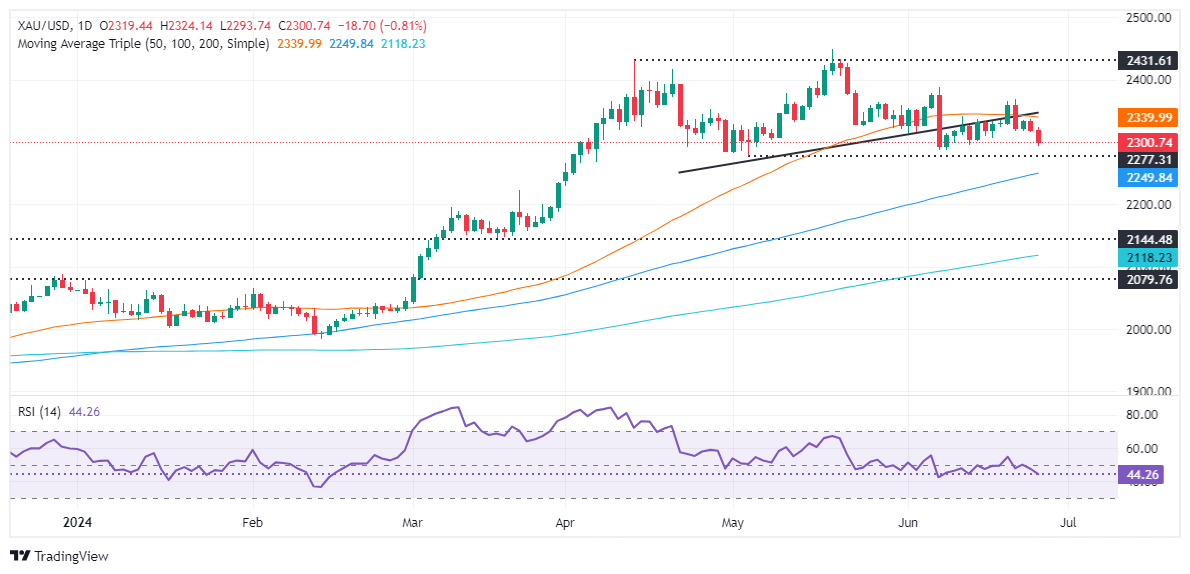Gold price slumps as US Dollar soars amid high US yields
- Gold drops pressured by strong USD and rising Treasury yields.
- DXY hits new monthly peak at 106.13, 10-year yield is up 5.5 bps.
- Fed’s Bowman hints at steady policy and possible hikes if inflation falters.
- Upcoming PCE report expected to show mild inflation decline.
Gold price slumped more than 0.70% on Wednesday as the Greenback soars, underpinned by high US Treasury yields, ahead of the release of the Personal Consumption Expenditures (PCE) Price Index report on Friday. Investors are beginning to price out less easing by the Federal Reserve (Fed), sponsoring the buck’s last leg up. The XAU/USD trades at $2,301 after hitting a daily high of $2,323.
The US Dollar Index (DXY) hit a new monthly high of 106.13 due to the jump in US yields. The 10-year Treasury note yield gains five and a half basis points (bps) at 4.304%.
Fed Governor Michele Bowmanstated on Tuesday that monetary policy will remain steady for “some time” and added that a rate hike would be needed “should progress on inflation stall or even reverse.”
Focus this week will be on the Fed’s preferred gauge for inflation, the May PCE, which is expected to drop from 2.7% to 2.6% YoY, while core PCE is foreseen at 2.6% YoY, down from 2.8%.
Other data will be released, such as the Gross Domestic Product (GDP) Q1 2024 final reading, Durable Goods Orders and Initial Jobless Claims.
Daily digest market movers: Gold price extends its losses on strong US Dollar
- On Monday, San Francisco Fed President Mary Daly leaned dovish as she said, “At this point, inflation is not the only risk we face,” expressing worries about the labor market.
- Fed Governor Lisa Cook was neutral on Tuesday, saying that inflation was most likely to fall “sharply” next year, adding that it would be necessary to ease policy to keep the Fed’s dual mandate more balanced.
- On Thursday, the US economic docket will feature the release of Q1 GDP, expected to end at 1.4% QoQ, down from last year’s Q4 3.4%.
- Durable Goods Orders for May are expected to contract from 0.7% to -0.1%.
- According to CME FedWatch Tool, odds for a 25-basis-point Fed rate cut in September are at 56.3%, down from 59.5% last Tuesday.
- The December 2024 fed funds rate futures contract implies the Fed will ease policy by just 35 basis points (bps) toward the end of the year.
Technical analysis: Gold price respects Head-and-Shoulders neckline, prints new low below $2,300
Gold price remains bearishly biased as the Head-and-Shoulders chart pattern remains in play. The XAU/USD spot price has been unable to crack the neckline, validating the chart pattern, which hints that further downside is expected.
Therefore, the XAU/USD next support would be $2,300. Once cleared, the non-yielding metal would fall to $2,277, the May 3 low, followed by the March 21 high of $2,222. Further losses lie underneath, with sellers eyeing the Head-and-Shoulders chart pattern objective from $2,170 to $2,160.
Conversely, if Gold reclaims $2,350, that will expose additional key resistance levels like the June 7 cycle high of $2,387, ahead of challenging the $2,400 figure.

Gold FAQs
Gold has played a key role in human’s history as it has been widely used as a store of value and medium of exchange. Currently, apart from its shine and usage for jewelry, the precious metal is widely seen as a safe-haven asset, meaning that it is considered a good investment during turbulent times. Gold is also widely seen as a hedge against inflation and against depreciating currencies as it doesn’t rely on any specific issuer or government.
Central banks are the biggest Gold holders. In their aim to support their currencies in turbulent times, central banks tend to diversify their reserves and buy Gold to improve the perceived strength of the economy and the currency. High Gold reserves can be a source of trust for a country’s solvency. Central banks added 1,136 tonnes of Gold worth around $70 billion to their reserves in 2022, according to data from the World Gold Council. This is the highest yearly purchase since records began. Central banks from emerging economies such as China, India and Turkey are quickly increasing their Gold reserves.
Gold has an inverse correlation with the US Dollar and US Treasuries, which are both major reserve and safe-haven assets. When the Dollar depreciates, Gold tends to rise, enabling investors and central banks to diversify their assets in turbulent times. Gold is also inversely correlated with risk assets. A rally in the stock market tends to weaken Gold price, while sell-offs in riskier markets tend to favor the precious metal.
The price can move due to a wide range of factors. Geopolitical instability or fears of a deep recession can quickly make Gold price escalate due to its safe-haven status. As a yield-less asset, Gold tends to rise with lower interest rates, while higher cost of money usually weighs down on the yellow metal. Still, most moves depend on how the US Dollar (USD) behaves as the asset is priced in dollars (XAU/USD). A strong Dollar tends to keep the price of Gold controlled, whereas a weaker Dollar is likely to push Gold prices up.



